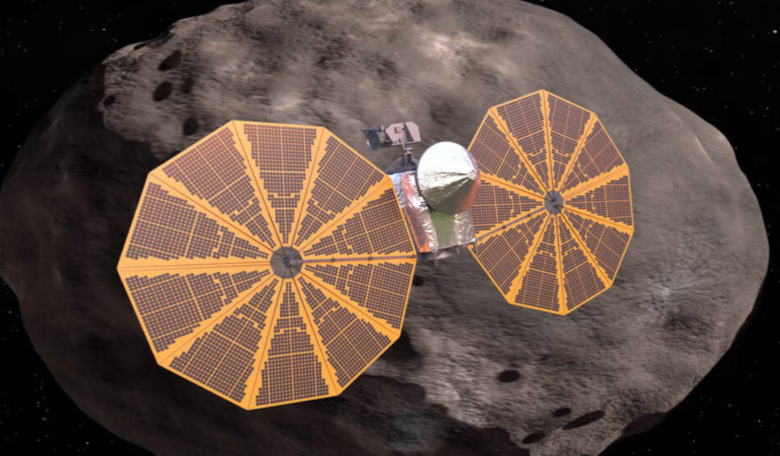Despite a successful launch at the weekend, a solar array on NASA’s Lucy space probe may not be fully latched after they unfurled in orbit, said the US space agency in a statement. All other subsystems are normal and the team are analysing spacecraft data to understand the situation, NASA said.
Designed to unfurl “like Chinese fans,” Lucy’s two huge solar panels straddle either side of its instrument pointing platform (IPP) to make up the bulk of the craft.
Although they are only a mere 10 centimetres (4 inches) thick when folded up, once expanded each solar panel has a diameter of nearly 7.3 meters (24 feet).
As big as these impressive circular arrays are, the panels generate around 500 watts, about equivalent to the energy needed to run a washing machine.
That might not seem like a lot, but it will be enough to power Lucy throughout its entire 6.4-billion-kilometre, 12-year journey through space as it heads out to explore Jupiter’s elusive Trojan asteroids.
But, in order to assure that there is enough energy to power the spacecraft throughout the mission, the solar panels will need to deploy flawlessly, said Principal Investigator Hal Levison of the Southwest Institute in Boulder, Colorado earlier this year.
Those 20 minutes while the solar panels unfurl “will determine if the rest of the 12 year mission will be a success,” Levison said. “Mars landers have their seven minutes of terror, we have this.”
Unfortunately for Levison and the rest of the Lucy mission, those 20 minutes are not quite over. The latest report by NASA says that Lucy has deployed both panels, both are producing power and the battery is charging say NASA, but while one of the arrays has latched, indications are that the second array may not be fully latched.
Could the space agency’s 13th mission in its Discovery Programme prove unlucky for Lucy?
“This team has overcome many challenges already and I am confident they will prevail here as well,” Thomas Zurbuchen, NASA associate administrator for science, tweeted 17 October.
In the current spacecraft attitude, Lucy can continue to operate with no threat to its health and safety say NASA in its statement, but it is unclear if the problem will other affect key tests such as the deployment of the IPP which is scheduled for about two days after launch.
Meanwhile, Lucy has sent its first signal to Earth from its own antenna to NASA’s Deep space Network. The spacecraft is now traveling at roughly 108,000 kph (67,000 mph) on a trajectory that will orbit the Sun and bring it back toward Earth in October 2022 for a gravity assist
Named after the world's most famous early human ancestor, the 3.2-million-year-old ape "Lucy”, whose skeleton provided unique insight into humanity's evolution, NASA hopes Lucy the space probe will revolutionise our understanding of the Solar System by studying “fossils” of planetary formation; Trojans.
Clustered in two loose groups in an orbit around Jupiter – one group leads ahead of the gas giant in its path, the other trails behind – Trojans are thought to be remnants of the primordial material that formed the outer planets more than 4 billion years ago.
There could be as many as one million trojans larger than 1 kilometre in diameter in orbit around Jupiter and of these, Lucy will target eight of them; a Main Belt asteroid and seven Trojans, four of which are binary systems.
Providing Lucy is able to continue with its mission, the probe’s complex path will take it to both clusters of Trojans and give scientists the first close-up view of all three major types of bodies in the swarms (so-called C-, P- and D-types).
The dark-red P- and D-type Trojans resemble those found in the Kuiper Belt of icy bodies that extends beyond the orbit of Neptune. The C-types on the other hand are found mostly in the outer parts of the Main Belt of asteroids, between Mars and Jupiter.
Although no firm evidence of the presence of water, or any other specific compound on their surface has been observed, it is thought that they are coated in tholins, organic compounds such as carbon dioxide (CO2), methane (CH4) and ethane (c2H6) formed by the Sun's radiation.
To date, no mission has gone through the regions in space where Jupiter Trojan asteroids are found and with the potential to unlock the answers to fundamental questions about planetary formation and migration, many have high hopes for Lucy.
“We started working on the Lucy mission concept early in 2014, so this launch has been long in the making,” Levison said at the launch on Saturday. “It will still be several years before we get to the first Trojan asteroid, but these objects are worth the wait and all the effort because of their immense scientific value. They are like diamonds in the sky.”











